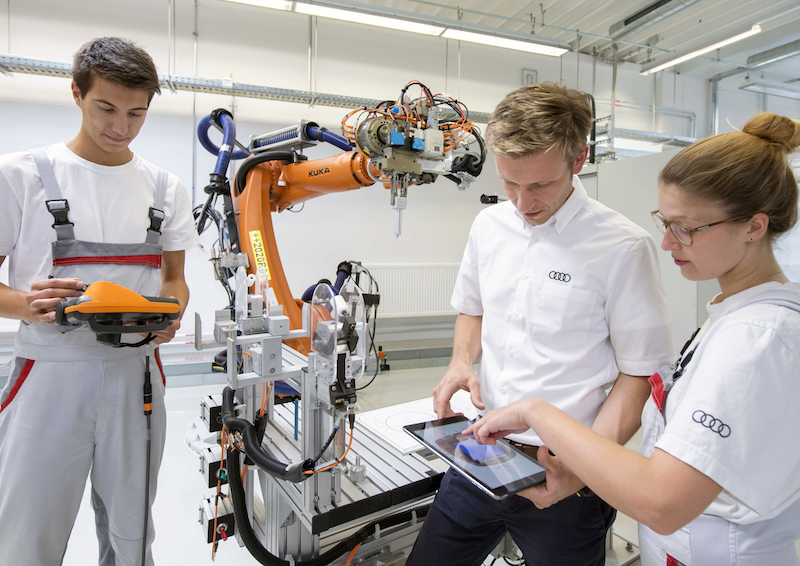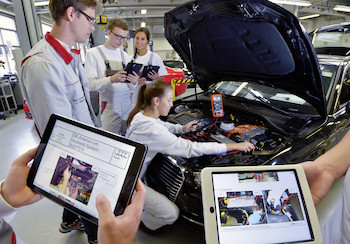Brian Fortney, global business lead, Workforce and Training Services, at Rockwell Automation tells AMS how automotive companies can prepare for a digitally connected era – and the arrival of the millennial generation
 Joanne Perry (JP): Can you explain what OEMs normally ask Rockwell to do as a training provider?Brian Fortney (BF): If they’re thinking about workforce development in the right vein, they ask Rockwell to create training that is relatable, and easy to apply and deliver to their workforce. And they come into that with a true understanding that they have both a changing workforce and multiple changing technology patterns. Automakers more than any other [type of] manufacturer in North America understand [that] the changing dynamics of their workforce, married with the accelerating adoption of new technologies for manufacturing, presents a huge opportunity. I want to clarify [that] what we’re asked for is not always what a customer will choose to invest in, but the ‘ask’ is consistently: comprehensive, multi-system, customer-specific workforce competency.
Joanne Perry (JP): Can you explain what OEMs normally ask Rockwell to do as a training provider?Brian Fortney (BF): If they’re thinking about workforce development in the right vein, they ask Rockwell to create training that is relatable, and easy to apply and deliver to their workforce. And they come into that with a true understanding that they have both a changing workforce and multiple changing technology patterns. Automakers more than any other [type of] manufacturer in North America understand [that] the changing dynamics of their workforce, married with the accelerating adoption of new technologies for manufacturing, presents a huge opportunity. I want to clarify [that] what we’re asked for is not always what a customer will choose to invest in, but the ‘ask’ is consistently: comprehensive, multi-system, customer-specific workforce competency.
JP: By “changing dynamics”, do you mean demographic changes such as an ageing workforce?BF: I think you have two forces colliding. You have the ageing workforce that potentially has the eye on the door – they’ve put in their 25, 30, 35 years – and you [also] have this new workforce with a completely different mindset and some very unique benefits to the labour market as a whole. Think about the benefits that the millennials, Gen X [and] Gen Y bring. They’re incredibly fluid in technology adoption but also fluid in technology change. It doesn’t really matter to this group whether or not they’re using an iPhone, a tablet [or] a Droid. The platform and their adoption of it stays consistent – whereas a more ageing workforce is concerned about being able to manage the difference between an iPhone and a Droid.
JP: What has Rockwell’s response been to these changes?BF: It’s been two-fold, because manufacturing as a whole is not always early in the cycle of adoption. One of our top 20 most popular classes in fiscal year 2016 was PLC 5 Maintenance and Troubleshooting. This is a technology that was developed and released essentially in 1986. We still have to support the technicians who are manufacturing in that market, but we’ve also seen in our top 20 classes IMINS and IMINS 2. These are our partnerships with Cisco and at the leading edge of where converged operation and information technology is going. So within our top 20 classes you see both ends of the spectrum and what we as a company are doing is serving both markets and making it easy for our manufacturers and their workforces to attain the training on the technology that they use each and every day.
“The way training is delivered will evolve. There will be more of it but it may be in smaller chunks; it may be delivered in different voices and styles than what we have seen in the past” – Brian Fortney, Rockwell
JP: Do automotive suppliers have different requirements from those of vehicle-makers?BF: I think the macro trends in the workforce exist for all organisations and you can apply that even more broadly to say, for the first time possibly in history, [that] a paper mill has the same challenges as an automaker or tier-one supplier. Where I think the differentiation comes is in the specialisation of application, and the ability to fund and develop talent. Automakers are unique in their scale, that they can develop and deliver the most customised workforce development programmes and do so in a train-the-trainer model. Many other types of manufacturer don’t have the scale of workforce to be able to cost-effectively execute on a programme like that.
JP: Is train-the-trainer the standard method or are there other options?BF: There’s a multitude of options that you can do. The train-the-trainer model is a strong strategic play if you have the capabilities and willingness to develop the skills to train others within your team. So by that I mean, what thought process do you give to developing a trainer? If you’re looking to develop a trainer, ask them what they do in their off hours. If candidate A tends to remain in their basement [and] build up model trains on T-scale, they’re probably a great technician; if candidate B coaches their children’s local softball league, you choose candidate B – all the time. Because training isn’t about having encyclopaedic technical knowledge – that’s always good, but it’s about having the ability to communicate and transfer that knowledge effectively. You have to look at your selection process and your talent pool to be able to execute that.
You also have to look at the time that an automaker or supplier has to become operational on a new system or technology. If they have a short cycle to achieve this training, a train-the-trainer programme may not be the correct way to go. They may need to look at having Rockwell coming in to provide that training. We have seen one global manufacturer in path A with train-the-trainer, we’ve seen another do it in path B, having our instructors onsite essentially 24 hours a day for 12 weeks.
“In our experience, the millennials are embracing the challenges of the digital future in the working environment, as they mirror their own experiences with digital devices in their personal lives,” an Audi spokesperson tells AMS, echoing the findings of training provider Rockwell Automation. The vehicle-maker is meeting its new recruits halfway and has introduced mobile learning with tablet computers, which both suits the interests of younger personnel and should help Audi to capitalise on their digital aptitude. Indeed, the spokesperson says an internal study has shown that this focus on “self-organisation, the combination of practical and theoretical knowledge as well as the option to learn anytime and anywhere” increases the motivation and success of trainees.

Audi is hiring increasing numbers of this new generation of digitally minded worker, announcing in September a record intake for occupational training at Ingolstadt and Neckarsulm in Germany (531 and 273 respectively – up by 10% on recent years). Beyond simply boosting the size of its workforce, the key aims are to better position the company for important trends in automotive manufacturing, namely digitisation and electric mobility. “We provide young people with important expertise for working in the digital factory,” commented Dieter Omert, head of vocational training and the development of specialist expertise at Audi.
The number of mechatronics apprentices, for example, has increased by 20% to 162. Audi’s spokesperson describes these young recruits as “crucial for the future success of the company” because new production technologies will require specialists in fields such as human-robot cooperation. Moreover, production lines will increasingly involve the use of mobile devices to control installations wirelessly as well as to share data in real-time with teams at other facilities around the world.
There might be a need for specialists, but it is also important for employees to acquire a broader understanding and extra skills. For example, training for the job role of computer specialist for system integration includes an additional qualification as a specialist electrician. Or, as Omert explained, Audi is preparing them for “working in an increasingly connected company”.
We also offer soft skills training. We have an entirely different workforce [now] stepping into these roles. If you’ve ever stood at the end of an automotive line that has ground a halt, it is not the most genteel place you may ever find yourself. And millennials coming in have not faced that type of episodic criticism, the type of intense conversation that occurs in those moments and they can freeze – it happens. We are now looking at how do we help them to communicate with clarity, how do we help provide training on feedback, delegation, things like that.
My grandfather in the late ‘20s stepped out of West Virginia to come to Goodyear – an opportunity to be in the rubber shops rather than in the mines. He did not have the mindset of “why are you yelling at me?” or “this isn’t my fault, what do you want me to do?”. He had the mindset of “we just get it done”. And helping to instil that while helping to build a culture that reflects these differences within the workforce is critical to the long-term success of any organisation, not just automotive.
JP: Does the trend among carmakers towards globalisation of production mean globalisation of training?BF: I think that it means the globalisation of training but there is not a definition of what that globalisation means. We’ve taken programmes from Detroit to Sanand, India, to San Luis Potosí, Mexico, to Romania – we’ve taken programmes throughout the world. Globalisation means different things; does it mean translation, does it mean an exact match to the initial architecture? I think the global training transformation clearly involves core tenets but with the flexibility to meet the local market requirements.
JP: It seems that younger workers will be well-suited to changes in the industry like the 4.0 revolution. Will this reduce training requirements?BF: I think the needs only increase. You have this workforce that is engaged in the digital space – embedded within the digital space, to be quite frank. But they’re embedded in their own personal digital space – [with] the rise of social media. You have to have more training because the tactics and the decisions that ensure a safe and reliable manufacturing network run in conflict to the tactics of an embedded digital individual. If you think about how you grow from strategic advantage, especially in the automotive space, you have to grow from a unique usage of technology – on the consumer or manufacturing side – and that’s something that you have to protect while you continue to develop it. You have the millennials coming in where their entire digital mantra is essentially share – share everything!
“Training isn’t about having encyclopaedic technical knowledge, it’s about having the ability to communicate and transfer that knowledge effectively” – Brian Fortney, Rockwell
More training will be needed because we have to change in some ways their mindset and their usage and consumption of digital technology. But the way training is delivered will evolve. There will be more of it but it may be in smaller chunks, in a pattern; it may be delivered in different modalities to support that audience. It may be delivered in different voices and styles than what we have seen in the past, ie training is “you must do this – warning, warning, warning!”. Training now for that audience will be much more collaborative: “here’s how we win together when we do this”. It’s a shift in the delivery styles but no reduction in the volume needed.
JP: It sounds like there will be a lot of opportunities but also some difficulties to overcome.BF: This is a really fun time to be in this space. Because everywhere I go – to a multitude of facilities and different industries, not just automotive – [I] hear this unified challenge. It almost can be summed up as: the greatest enemy of North American manufacturing is not foreign competition, it’s the high-school counsellor. How do we develop and grow a population that desires these jobs? There is nowhere I travel in this nation [the US] that I hear “there are too many candidates for me to hire”. I hear the same story: “we can’t find the skillset we need”.
As automotive manufacturing becomes more globalised, companies face the need to ensure that disparate facilities meet worldwide standards, especially when products are exported from low-cost locations to high-value markets. Tyre supplier Continental, for one, standardises key operation management processes across all markets in order to cope with fluctuating production. According to Yvonne Yang, head of Human Relations, Central Electronic Plants, this enables the company to move engineers, technicians and line workers to wherever demand is greatest, adding that this shifting of personnel occurs “particularly in Eastern Europe”.
The starting educational level of recruits varies across the different markets, so one strategy Continental has adopted to get workers up to an appropriate standard is the selection of students at college or university and the shaping of their curriculum in partnership with the relevant educational institution.
Around the world, the company’s training projects include:
– The installation of a technical training centre at Sibiu, Romania, to provide certification for new employees but also requalification for existing workers. Within this centre, the technical academy offers training seven-month programmes authorised by the Ministry of Education, for technicians and employees with the potential to occupy technical positions. At Sibiu, some of the machines are now activated by ID cards which verify the qualifications of the workers;
– At Manila in the Philippines, Continental works with the local university to develop a degree programme in line with its skills needs;
– In China, the company has collaborative arrangements with local technical schools as a channel for recruitment.
In addition, knowledge is spread throughout the company via a network of competence centres, each of which excels in a particular technology. Experts are sent on eight-week secondments at other plants to work in their area of expertise, share knowledge and foster a culture of learning.
For new line workers, Continental’s qualification process takes between one and four weeks, depending on job complexity and individual learning abilities. The programme consists of three stages: onboarding, involving familiarisation with the company and plant; on-the-job training for a specific role; and requalification to ensure sustainable proficiency. As for the techniques involved, Continental uses a mixture of classroom teaching, the train-the-trainer model; networking events; coaching and mentoring; and simulation and video tutorials. Reflecting the move towards digital methods across training as a whole, Continental is in the process of developing “eLearning and blended learning solutions”, according to Yang, and will soon integrate “a worldwide Learning Management System”.


































